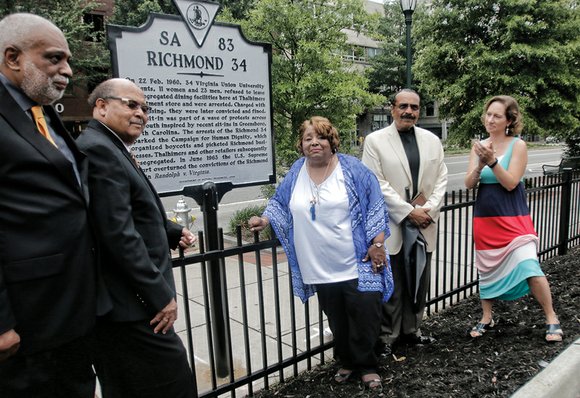‘Richmond 34’ student sit-in commemorated with state marker
7/2/2016, 12:18 a.m.

By Bonnie N. Davis
Elizabeth Johnson Rice was among 34 Virginia Union University students who were arrested after they staged a sit-in at Thalhimers department store in 1960 for its refusal to serve African-Americans in its restaurants.
Mrs. Rice again was center stage this week at the site of the former Downtown store for a more celebratory reason: The unveiling of a Virginia historical marker commemorating the students’ heroic actions 56 years ago.
As the lead organizer of Tuesday’s dedication program, the retired educator is elated by the marker.
“Just the fact we’re being remembered feels good,” Mrs. Rice, 75, said. “This historical marker will be there when we’re all gone.”
The marker, erected by the state Department of Historic Resources, is on East Broad Street between 7th and 8th streets, where Thalhimers once stood. The store closed in 1992 and was demolished in 2004.
This is the third marker erected in Richmond to commemorate the sit-in and the second to be placed on the site of the former department store, which is now a parking lot as well as a portion of the Dominion Arts Center complex at 7th and Grace streets.
The VUU students’ protest and sit-in on Feb. 22, 1960, was inspired by the historic Woolworth’s lunch counter sit-in in Greensboro, N.C. launched Feb. 1, 1960, by four students from North Carolina A&T State University. Their sit-in fueled similar student protests throughout the South challenging segregation.
Like many stores in the South, Thalhimers allowed African-Americans to shop at the store, but would not allow them to try on clothing or to return unsatisfactory items. The store also did not serve African-Americans at its lunch counter or in its full-service restaurant.
The local NAACP raised money to help bail the students out of jail. Contributions to the bond fund also came from the late Dr. Allix B. James, then VUU’s vice president, who put up his house as collateral.
The 34 students were convicted, but the convictions were thrown out in June 1963, when the U.S. Supreme Court struck down segregated restaurants and lunch counters as a violation of the U.S. Constitution’s equal protection clause under the 14th Amendment.
Dr. Raymond Hylton, a VUU professor and historian, said the state marker recognition was overdue.
“Many have overlooked or forgotten the significance of the students’ action,” he said. “Their action led to the breakdown in legalized segregation in Richmond’s business sector and helped establish a campaign for human dignity.”
Mrs. Rice and Dr. Hylton were surrounded during the ceremony by several of the Richmond 34. They were joined by Elizabeth Thalhimer Smartt, the great-great-great-granddaughter of the store’s founder, and James Hare, an architectural historian and director of the Division of Survey and Register for the Department of Historic Resources.
“The struggle is never over,” said Mrs. Smartt, who has written a book, “Finding Thalhimers,” about her family’s history. “This story was very complicated.”
She recalled her grandfather, William Thalhimer Jr., telling her that he initially refused to desegregate the restaurants because he was at risk of losing the family’s 100-year-old business.
“But (over time), he made the right decision,” she said.
Mr. Hare said that the marker shows how people can make history by taking a stand and doing what they believe is right.
“We hope to do more to commemorate civil rights history in Virginia,” he said.
Two stone markers were set up in Richmond during a week of festivities in 2010 to mark the 50th anniversary of the sit-in.
One of the markers, put in place on Feb. 18, 2010, is on the VUU campus in front of Martin E. Gray Hall. The second was placed on 6th Street, between Broad and Grace streets, on Feb. 22, 2010. Those markers are still in place.






